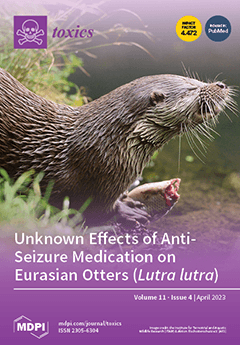The global prevalence of diabetes, and its major complication, diabetic nephropathy, have reached epidemic proportions. The toxic metal cadmium (Cd) also induces nephropathy, indicated by a sustained reduction in the estimated glomerular filtration rate (eGFR) and the excretion of β
2-microglobulin (β
2M) above 300 µg/day, which reflects kidney tubular dysfunction. However, little is known about the nephrotoxicity of Cd in the diabetic population. Here, we compared Cd exposure, eGFR, and tubular dysfunction in both diabetics (
n = 81) and non-diabetics (
n = 593) who were residents in low- and high-Cd exposure areas of Thailand. We normalized the Cd and β
2M excretion rates (E
Cd and E
β2M) to creatinine clearance (C
cr) as E
Cd/C
cr and E
β2M/C
cr. Tubular dysfunction and a reduced eGFR were, respectively, 8.7-fold (
p < 0.001) and 3-fold (
p = 0.012) more prevalent in the diabetic than the non-diabetic groups. The doubling of E
Cd/C
cr increased the prevalence odds ratios for a reduced eGFR and tubular dysfunction by 50% (
p < 0.001) and 15% (
p = 0.002), respectively. In a regression model analysis of diabetics from the low-exposure locality, E
β2M/C
cr was associated with E
Cd/C
cr (β = 0.375,
p = 0.001) and obesity (β = 0.273,
p = 0.015). In the non-diabetic group, E
β2M/C
cr was associated with age (β = 0.458,
p < 0.001) and E
Cd/C
cr (β = 0.269,
p < 0.001). However, after adjustment for age, and body mass index (BMI), E
β2M/C
cr was higher in the diabetics than non-diabetics of similar E
Cd/C
cr ranges. Thus, tubular dysfunction was more severe in diabetics than non-diabetics of similar age, BMI, and Cd body burden.
Full article






